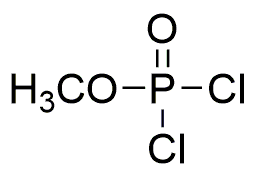Methyl dichlorophosphate is widely utilized in research focused on:
- Agricultural Chemicals: It serves as an intermediate in the synthesis of various pesticides and herbicides, enhancing crop protection and yield.
- Pharmaceuticals: The compound is used in the production of certain pharmaceuticals, providing a key building block for active ingredients in medications.
- Chemical Synthesis: Methyl dichlorophosphate is employed in organic synthesis, particularly in the preparation of phosphonates and phosphoric acid derivatives, which are essential in various chemical processes.
- Laboratory Reagents: It acts as a reagent in analytical chemistry, aiding in the detection and quantification of specific compounds, thus facilitating research and quality control.
- Industrial Applications: The compound is utilized in the manufacturing of flame retardants and plasticizers, contributing to the production of safer and more durable materials.
General Information
Properties
Safety and Regulations
Applications
Methyl dichlorophosphate is widely utilized in research focused on:
- Agricultural Chemicals: It serves as an intermediate in the synthesis of various pesticides and herbicides, enhancing crop protection and yield.
- Pharmaceuticals: The compound is used in the production of certain pharmaceuticals, providing a key building block for active ingredients in medications.
- Chemical Synthesis: Methyl dichlorophosphate is employed in organic synthesis, particularly in the preparation of phosphonates and phosphoric acid derivatives, which are essential in various chemical processes.
- Laboratory Reagents: It acts as a reagent in analytical chemistry, aiding in the detection and quantification of specific compounds, thus facilitating research and quality control.
- Industrial Applications: The compound is utilized in the manufacturing of flame retardants and plasticizers, contributing to the production of safer and more durable materials.
Documents
Safety Data Sheets (SDS)
The SDS provides comprehensive safety information on handling, storage, and disposal of the product.
Product Specification (PS)
The PS provides a comprehensive breakdown of the product’s properties, including chemical composition, physical state, purity, and storage requirements. It also details acceptable quality ranges and the product's intended applications.
Certificates of Analysis (COA)
Search for Certificates of Analysis (COA) by entering the products Lot Number. Lot and Batch Numbers can be found on a product’s label following the words ‘Lot’ or ‘Batch’.
*Catalog Number
*Lot Number
Certificates Of Origin (COO)
This COO confirms the country where the product was manufactured, and also details the materials and components used in it and whether it is derived from natural, synthetic, or other specific sources. This certificate may be required for customs, trade, and regulatory compliance.
*Catalog Number
*Lot Number
Safety Data Sheets (SDS)
The SDS provides comprehensive safety information on handling, storage, and disposal of the product.
DownloadProduct Specification (PS)
The PS provides a comprehensive breakdown of the product’s properties, including chemical composition, physical state, purity, and storage requirements. It also details acceptable quality ranges and the product's intended applications.
DownloadCertificates of Analysis (COA)
Search for Certificates of Analysis (COA) by entering the products Lot Number. Lot and Batch Numbers can be found on a product’s label following the words ‘Lot’ or ‘Batch’.
*Catalog Number
*Lot Number
Certificates Of Origin (COO)
This COO confirms the country where the product was manufactured, and also details the materials and components used in it and whether it is derived from natural, synthetic, or other specific sources. This certificate may be required for customs, trade, and regulatory compliance.


